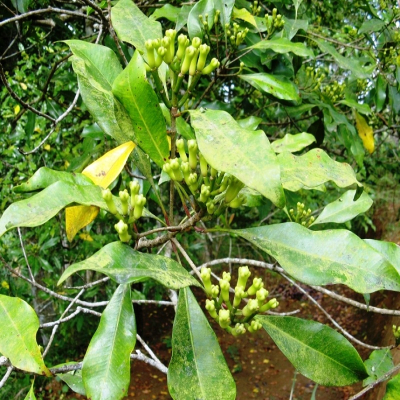Distribution and habitat: Cultivated in south India.
Botany: A conical evergreen tree usually up to 12 m in height with a single main stem bearing obliquely oriented branches.
- Leaves : Simple, lanceolate, 7-13 cm in length and 2-4 cm in breadth, gland-dotted, fragrant.
- Flowers: Buds greenish to pink, clustered at the ends of the branches, highly aromatic;
- Fruits: Fleshy dark pink drupes; seeds oblong, grooved on one side.
Chemical constituent: Isobiflorin, glucoside derivative, biflorin, eugenol and eugenine
Uses: They are useful in halitosis, odantalgia, ophtalmopathy, flatulence, colic, gastropathy, anorexia, cough, asthma, vitiated conditions, gastrohelcosis, flatulence, colic, skin diseases, dyspepsia, vomiting, odontalgia, dental carries and cephalalgia. Externally oil is used as a rubefacient and counterirritant, dark pink drupes; seeds oblong, grooved on one side.
Agrotechnology
Soil and climate: Tropical humid climate is best for growth of the plant. Deep, well drained and fertile loamy soil is best. Deep sand loamy soils with rich organic matter content and black loams of semi forest regions with good drainage are suited for the cultivation of the crop.
Propagation: By seeds and vegetative methods.
Irrigation: Summer irrigation is must. Irrigation must be done regularly in hot seasons.
Manures and fertilizers: The fertilizer application includes NPK at the rate of 20: 18: 50 g/plant in first year and 40:36:100 g/plant. Increase the dose to 300: 250:750 g/plant annually for a full grown tree. Apply compost or cattle manure at the rate of 15 kg/tree per year.
Pests and diseases: Shoot borer(Sinoxyon sp) attacks tender shoots of young plants. It can be prevented by using 0.15% carbaryl. Leaf spot, twig blight and flower bud shedding diseases are seen. Spraying 1% Bordaeux mixture is effective in controlling them .
Harvesting: Clove clusters are hand picked when the buds reach full size and turns pink but before they open. They are spread thinly on mats and stirred frequently for uniform drying.




